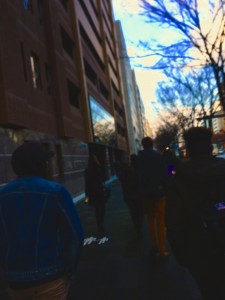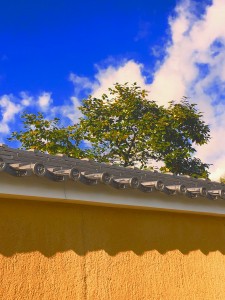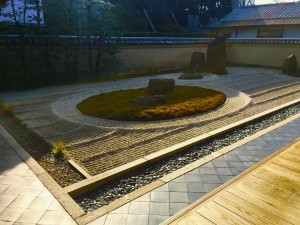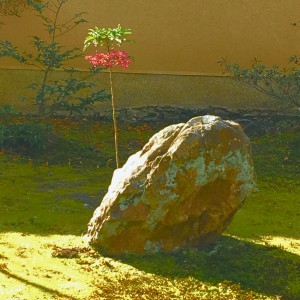
going to this morning’s lecture
We started the day off with a short lecture about Daitoku-ji’s history and layout. After finishing the lecture, we made our way to Izusen, along with a short walk through the Shōkoku-ji complex. The foliage was quite beautiful, and it got me thinking about how the landscape is planned. Later in the day while, at Daitoku-ji, I asked Prof. Ludvik (also the person who gave the lecture earlier) about these trees, and I learned that the monks consult with garden designers, so that certain trees are used and that they go through different stages at different times, a reminder that life is constantly in a state of change. Despite knowing that dry landscape gardens are meticulously designed, it had never occurred to me that the temple grounds would be the same.

some trees at Shōkoku-ji
After an amazing lunch at Izusen, we went to some of Daitoku-ji’s sub-temples. My favorite was Daisen-in because of the dry landscape garden. Its composition and integration in, and around, the building was stunning. The intent of representing a river was clearly legible, while still maintaining symbolic distance. Though the garden is connected throughout, there are many different view points created by the flow of the building as well as windows. Moving from a stretch with a boat, through a barrier, to see a cascade of rocks, a waterfall, really recalled the feeling of walking upstream. I also really enjoyed the garden at Ryogen-in. In contrast to the winding river of Daisen-in, the expanse at Ryogen-in recalls more sublime feelings.

garden at ryogen-in
Our last stop in Daitoku-ji was a guided tour through Juko-in. Unfortunately, my Japanese was not good enough to take in everything the guide was saying, but with some help, and at times by looking at the shōji intently, I was able to glean some of the narratives. Of the various things we saw, I appreciated Kanō Eitoku’s representation of the 4 seasons and Hiroshi Senju’s work. The seasons are connected subtly and visual cues guide you through, really impressing the harmony in cycles. Hiroshi Senju’s waterfalls were a little more confrontational to the eye. The blue and white, and their contrast, are incredibly sharp; and the lack of solid figures makes the room feel like an expanse of stylized, falling water.
Lastly, I really liked this rock that was on the grounds of Shōkoku-ji. It was sitting very much by itself, and also does not have a place in this narrative, so I feel its placement here is fitting.

a rock/plant combination who’s composition i very much enjoyed
